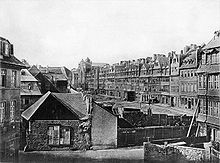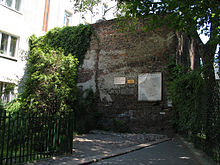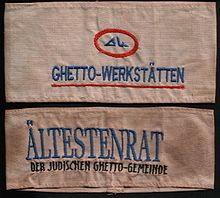Ghetto
![]()
The title of this article is ambiguous. For other meanings, see Ghetto (disambiguation).
A ghetto (recommended spelling by the Duden: Getto) is a segregated residential area. The term comes from the Italian and means foundry. It was later adopted as a term for a segregated residential area, since the Jewish inhabitants in Venice in 1516 were confined to the Ghetto Nuovo (new foundry).
With the papal bull Cum nimis absurdum, Paul IV decreed the compulsory ghetto for Jews living in the Papal States on 14 July 1555. This way of life in an assigned district or a single Jewish alley was maintained until Jewish emancipation in the 19th century.
During the Second World War (1939-1945), the National Socialists established completely different residential districts/ghettos in occupied Poland and the annexed Czech Republic for deported Jews. These detention camps served as transit stations before their transport to the extermination camps.
Colloquially, completely different city districts, again from both of the aforementioned areas, are nowadays referred to as ghettos because they are predominantly inhabited by members of certain ethnic groups (segregation) or social fringe groups. It is also used without a direct spatial reference in the discourse on delimitable social structures (subcultures, social networks).

Map of the Jewish Ghettos in Eastern Europe (1941-1945)
Etymology and history
Often Jews lived in segregated neighborhoods in Europe since antiquity, especially in the countries around the Mediterranean and since late antiquity also in the area of present-day Germany. Originally they could pursue almost all professions. They were usually granted full freedom of trade and were allowed to acquire real estate. In the medieval city, the individual social groups and occupational groups usually lived predominantly in a certain quarter or street, and so the majority of Jews also usually lived in a Judengasse (then called after them) or Judenviertel, in which the observance of the Sabbath commandments could be facilitated by the formation of a so-called "Eruv" (declared district within which certain work was also permitted on the Sabbath). Just as there were usually some Jews living outside this district, on the other hand, there were also gentiles living within the Jewish quarter.
Speyer in the 11th century represents an early example of the formation of a ghetto in the Holy Roman Empire. In the records of the Speyer bishop Hutzmann (Huozmann) it says:
"When I made the village of Speyer a city, I believed that I would increase the prestige of this place of ours a thousandfold by attracting Jews there as well. I settled those who moved in outside the dwellings of the other citizens, and so that they would not be so easily troubled by the insolence of the inferior people, I surrounded them with a wall."
The first settlement dates back to 1084 in the suburb of Altspeyer and represents the first documented ghetto.
Since the 13th century (first at the Provincial Council of Breslau in 1267), however, the Church increasingly demanded the spatial separation of Jews from the Christian population. Thus, from the end of the 14th century in Spain, from the 1420s in Savoy, from the middle of the 15th century in some German cities, and in the 16th century in Italy, ghettos were increasingly established, i.e., quarters of cities that were reserved for Jews only, outside of which no Jews were allowed to live in the city in question, and which were locked from the outside at night and often also on holidays. Although such ghettos often led to oppressive spatial confinement due to the increase in population, they were not poverty-stricken quarters from the outset: many inhabitants were wealthy craftsmen or merchants. However, the ghetto inhabitants were usually subject to considerable, sometimes discriminatory restrictions.
The name ghetto comes from the island of Ghetto in the Venetian district of Cannaregio, in the immediate vicinity of which there was a foundry (dialect term ghèto from getto = casting), which had to be sealed off from the rest of the city for reasons of fire protection. By a decree of 29 March 1516, the government of the Republic of Venice decided to consolidate the Jewish community there into a single district.
In 1555 Pope Paul IV had the Roman Ghetto established and obliged the Jews to live in this special area by the bull Cum nimis absurdum. Pope Pius V expelled all Jews from his domain on February 25, 1569. The only exceptions were the two ghettos in Rome and Ancona.
At the beginning of the 17th century, all capitals had a ghetto (except Livorno and Pisa). Walls ran around the ghettos and the gates were closed at night. Often, Jewish ghetto residents were forced to wear certain markings outside the ghetto that identified them as Jews.
The best known example of a German ghetto is Frankfurt's Judengasse, which existed from 1462 to 1796. In the beginning, the city council built eleven houses, a dance hall, a hospital, two inns and a community hall outside the city walls and forced the Frankfurt Jews to move here. Around 1550, this area was allowed to be expanded once again. After that, the Frankfurt magistrate did not allow any further expansion until the end of the ghetto, so that the growing population lived very cramped. The inhabitants were not allowed to leave the Judengasse at night and on Sundays and had to wear the "yellow patch" on their clothes. The ghetto was destroyed by French troops during the siege of Frankfurt in 1796, the residents were allowed to leave, and subsequently the ghetto constraint was lifted.
The dissolution of the ghetto system was largely a result of the French Revolution and the liberal movements of the 19th century. In 1870, the Roman ghetto was finally the only one in the world and was dissolved by the Italian King Victor Emmanuel II when he occupied the Papal States.
A parallel phenomenon in the Arab world are the mellahs in Moroccan cities. In Eastern Judaism, the Yiddish term shtetl existed for localities, villages or smaller towns that were predominantly inhabited by Jews.

Campo di Ghetto Nuovo, Venice 2005

Demolition of the former ghetto Judengasse Frankfurt, 1868 (Photography by Carl Friedrich Mylius)
Jewish residential districts/ghettos under National Socialism
The SS term for the collection camps (concentration camps) before further deportation to the extermination camps of the Shoa was consistently the German term Jüdischer Wohnbezirk or Jüdische Wohnsiedlung. The word Getto/Ghetto was also used as a short name or translation. However, this word took on a completely different meaning than the historical term. In Eastern Europe between 1939 and 1944 about 1150 ghettos were established by the German occupiers, about 400 of them on Polish and about 400 on Soviet territory. Very often the Jewish inhabitants of the localities were expelled or murdered beforehand.
See also: List of ghettos under National Socialism
Ghettoization by the German occupiers
As early as September 1939, on the secret orders of Reinhard Heydrich to the Einsatzgruppen of the Security Police and the SD, the concentration of Jews from the country in demarcated areas of Polish villages and towns, planned as temporary, began after the end of the invasion of Poland. There they were to be more easily controlled and used for temporary economic exploitation as forced laborers. Likewise, their assets could be systematically recorded there with the aim of Aryanization (robbery).
The beginning was made in the part of Poland occupied as the General Government. Preparatory measures were the compulsory identification of Jews, introduced here for the first time by the Germans, which was ordered by Governor General Hans Frank already at the end of November 1939 (white armband with a so-called Jewish star), which was later also introduced in the "Old Reich". At the same time, the "Higher SS and Police Leader East" Krüger, appointed by Himmler, ordered the Jewish population to observe nightly curfews and to refrain from settling outside their current place of residence.
Another measure was the formation of so-called Judenräte (Jewish councils), which were forcibly created as Jewish self-governing bodies by the German occupiers as their recipients of orders vis-à-vis the Jewish communities. They were first subordinated to the German civil administration, later to the SS and police forces. In practice, before and during the ghettoization, these "Judenräte" had to assemble teams for forced labor, organize the delivery of the remaining assets of the Jewish population, and finally, in the course of the dissolution of the ghettos from 1942, even help organize the deportation of the prisoners to the various extermination camps.
Ghettoisation itself, literally the concentration of the Jewish population in districts - sometimes (for example in the Warsaw Ghetto) cordoned off with walls and checkpoints - took place in Poland mainly from April 1940 to the end of 1941. The three largest residential districts or ghettos were the Warsaw Ghetto (October 1940, built in a part of the city declared a disease-free zone by the military administration in 1939), the Lodz Ghetto (April 1940) and the Lodz Ghetto (April 1940). ghettos were the Warsaw Ghetto (October 1940, built in a part of the city that the military administration had declared an epidemic exclusion zone in 1939), the Lodz Ghetto (April 1940), and - after the Germans had incorporated the conquered Soviet Galicia as the fifth district in what they called the "Generalgouvernement" - the Lemberg Ghetto (December 1943).
Other ghettos, some of them extensive, existed in various cities of the occupied part of the Soviet Union, for example the Kaunas ghetto, which became the Kauen concentration camp from September 1943, the Vilna ghetto or the Riga ghetto. Those Jews were imprisoned there who had not been murdered in the first wave of killings by the Einsatzgruppen of the Security Police and the SD in the second half of 1941. From the end of 1941, after the murder of the local inmates, Jews deported from the "Altreich" and the incorporated territories in Poland were taken there; these were no longer transported to the ghettos of the Generalgouvernement because the civil administration there had already resisted such plans in the spring of 1940 for reasons of capacity.
The Theresienstadt ghetto was established in the former garrison town of Terezín as a showcase ghetto. Prominent elderly Jewish personalities were deported there from all over Europe, but also families with children. For propaganda purposes, the film Theresienstadt was made in a late phase of the camp.
| Large ghettos | State | interned Jews | From | By | Transports to |
| Budapest | Hungary | 120.000 | November 1944 | January 1945 | Auschwitz |
| Lviv Ghetto | Ukraine | 115.000 | November 1941 | June 1943 | Belzec, Janowska |
| Litzmannstadt Ghetto | Poland | 200.000 | February 1940 | August 1944 | Chelmno, Auschwitz |
| Warsaw Ghetto | Poland | 450.000 | October 1940 | May 1943 | Treblinka, Majdanek |
See also:
- Chronology of the collaboration of the Vichy government in the Holocaust
- Deportation of the Jews from Hungary
- Deportation of German Jews
- Final Solution of the Jewish Question
Sinti and Roma
Since the persecution of the Sinti and Roma was often closely linked to the persecution of the Jews, they were also deported to ghettos in the General Government, such as the Siedlce Ghetto and the Lodz Ghetto.
Everyday life in the German "ghettos" in Europe
Daily life in the ghettos was marked by malnutrition, disease and death. Epidemics, for example typhus, were rampant due to the unspeakable hygienic conditions and the catastrophic food situation. Thus, high Nazi leaders lowered the bread ration and the ration of jam to 50 and 30 grams per month, respectively. In some cases, the inhabitants of the Warsaw ghetto could only obtain food by smuggling it in. They even managed to smuggle a cow into the ghetto in order to provide at least the newborns with milk. According to Heinz Auerswald, the commissar of the Warsaw Ghetto, the number of deaths in the Jewish residential districts of Warsaw increased by over 500 percent from January 1941 to August 1941, from 898 cases to 5560 cases. Auerswald cites malnutrition and typhus as the reasons for this. The Polish physician Ludwik Hirszfeld, who was imprisoned in the Warsaw Ghetto from 1941 to 1943, described the inhumane conditions there in the following vivid words:
"The streets are so overcrowded that it's hard to get ahead. Everyone is ragged, in tatters. Often one doesn't even own a shirt anymore. There is noise and shouting everywhere. Thin, pitiful children's voices drown out the noise. [...] On the sidewalks, feces and garbage pile up in heaps and mounds. [...] I see an enormous number of men and women being chased by the police. The old, the crippled and the infirm are liquidated on the spot. [...] Often something covered with newspapers lies on the pavement. Horribly emaciated limbs or morbidly swollen legs usually peek out from underneath. These are the cadavers of those who have died of typhus and are simply carried out by their fellow residents in order to save on funeral expenses. Thousands of ragged beggars are a reminder of starving India. Horrible spectacles are witnessed daily."
In the early 1940s, the anti-Semitic hate newspaper Der Stürmer even sent a photo reporter to the Warsaw Ghetto. Later, the Stürmer published an almost sadistic report on life in the ghetto. The German occupation authorities strictly limited the food supply, and efforts were made to minimize the costs for the catastrophic supply of the ghettos by hiring out prisoners - where possible due to the size of the ghetto - in ghetto-owned enterprises and in external enterprises or labor camps, thus generating income. Some industrialists made such high profits with the help of these "ghetto businesses" that they were able to amass a huge fortune.
Organization of the "Final Solution
In 1942 - after the "Final Solution of the Jewish Question" had been announced and settled in detail within the government at the Wannsee Conference in Berlin in January, including the secrecy orders - the systematic emptying of the ghettos of their inhabitants was begun. For the most part, the ghetto inhabitants were deported by train to the murder centers of the extermination camps, which in the Warsaw Ghetto eventually led to armed insurrection. In some cases, however, the ghettos were liquidated by shooting their inhabitants on the spot. This is how the SS proceeded, especially in the occupied parts of the Soviet Union, for example in Minsk and Riga, but also in large parts of Poland (as an example Mielec, Izbica). See also: Holocaust → Ghettoization
Legal reconditioning
Since the organization of forced labor by the Judenräte had the characteristics of a regular employment relationship, this resulted in pension claims for the workers or their survivors. After various court proceedings, this was legally specified in the Ghetto Pensions Act in 2002. As the provision had initially only been interpreted for voluntary employment, the Federal Social Court clarified it in favour of the claimants in 2009 due to several appeal proceedings.
The so-called ghetto in Shanghai
The Shanghai Ghetto, then called the Restricted Sector for Stateless Refugees or Designated Area in the Hongkou Municipality, was an area of approximately 2.5 square kilometers in the Chinese city of Shanghai, which had been occupied by Japan during World War II. This closed-off area is historically a special case in the context of the Shoa (Holocaust). It was not under German but Japanese control and could be used temporarily as a place of refuge for Jewish citizens from Europe. In part, a few Jewish refugees were still able to leave the German Reich or travel to the Soviet Union until September 3, 1941 (with the help of Japanese embassy officials in Vienna and Vilnius, Lithuania). The Japanese-occupied city was liberated in 1945. In the district about 20,000 Jewish refugees survived the Shoa.

Announcement on the Reduction of the Litzmannstadt Ghetto of 22 August 1944

Children's transport to Kulmhof extermination camp, Litzmannstadt ghetto, 1942

Forced labor on the Vistula, Wehrmacht propaganda photo, May 1941

Remains of the wall of the Warsaw Ghetto from the NS era (2005)

Call to register property, Piotrków Trybunalski Ghetto, 1940

Armbands from a Jewish ghetto
Questions and Answers
Q: What was the original meaning of the word 'ghetto'?
A: The original meaning of the word 'ghetto' was the Jewish quarter of Venice.
Q: Did other European towns have ghettos?
A: Yes, many other European towns had ghettos.
Q: What does the term 'ghetto' commonly refer to now?
A: The term 'ghetto' is now commonly used to refer to any poverty-stricken urban area with a concentration of minority groups.
Q: Where did the Jews in Venice live?
A: The Jews in Venice were only allowed to live in the area where the iron foundries were.
Q: What is one of the possible sources of the word 'ghetto'?
A: One of the possible sources of the word 'ghetto' is "getto," the Venetian word for foundry slag.
Q: What does the Italian word 'borghetto' mean?
A: The Italian word 'borghetto' means a little borgo or 'borough.'
Q: Is the term 'ghetto' used to refer to desirable areas?
A: No, the term 'ghetto' is used to refer to areas that are considered to be undesirable.
Search within the encyclopedia